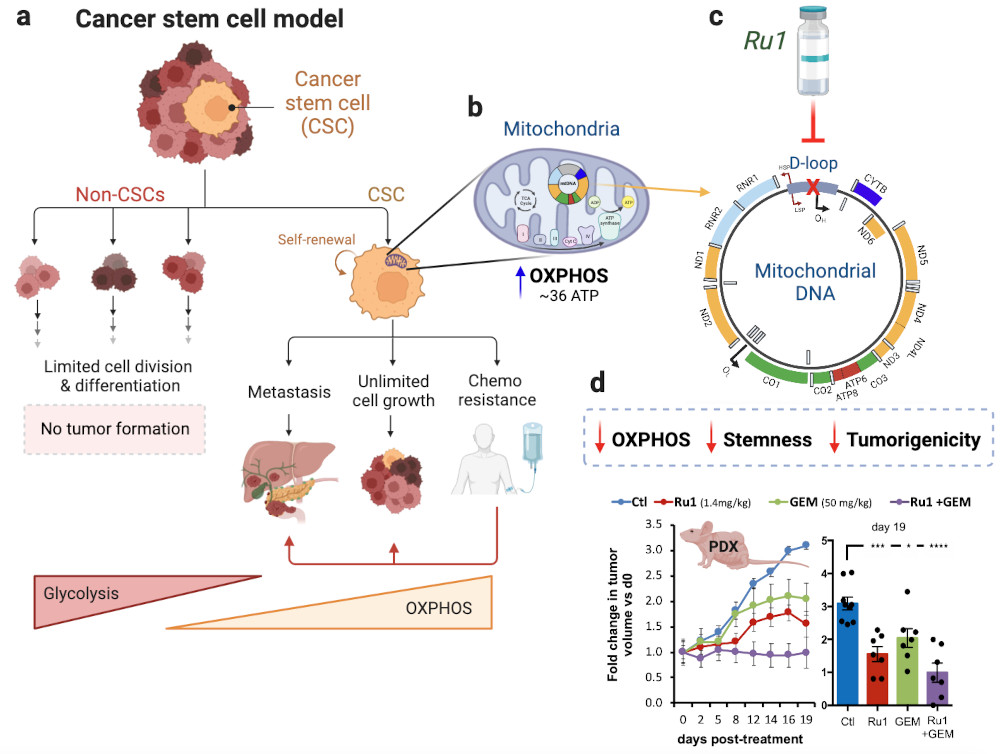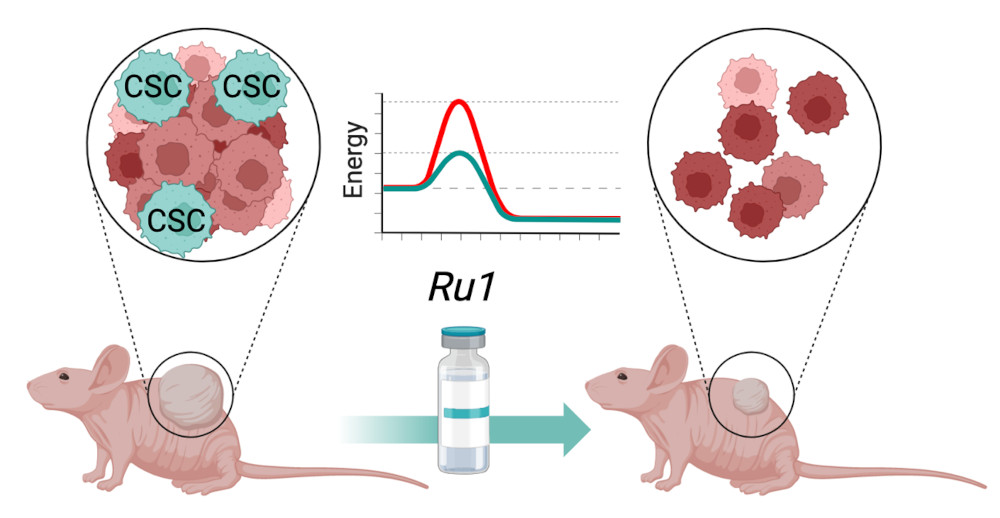Dr. Bruno Sainz Anding, principal investigator of a study published in a reference journal in the field of cancer -Journal of Experimental and Clinical Cancer Research- describes a new metal-based compound that targets mitochondrial respiration of cancer stem cells, decreasing their tumor-generating potential.
This work has been led by Dr. Bruno Sainz Anding, head of the Cancer Stem Cells and Fibroinflammatory Microenvironment Group of the Instituto de Investigaciones Biomédicas Sols-Morreale, IIBM (CSIC-UAM) and the Instituto Ramón y Cajal de Investigación Sanitaria (IRYCIS) and Prof. JL Mascareñas of the Centro Singular de Investigación en Química Biolóxica e Materiais Moleculares (CiQUS) from the University of Santiago de Compostela (USC).

This multi-disciplinary and collaborative effort between cancer stem cell (CSC) biologists and chemists has resulted in the identification of a metal-based compound (Ru1) that exerts an impact on CSCs, diminishing their ability to form tumors. For several years, Professor Mascareñas' laboratory has been engaged in research focused on metal complexes, with a specific focus on DNA and mitochondrial DNA interactions. Using one of these compounds, specifically Ru1, Drs. Sonia Alcala and Laura Ruiz, from the Cancer Stem Cells and Fibroinflammatory Microenvironment Group group, conducted extensive studies using primary CSC cultures and mice implanted with patient tumors (i.e., Patient-derived xenografts), revealing a robust anti-tumor effect of Ru1 in pancreatic, colorectal, and osteosarcoma tumors, with minimal secondary toxicity. Importantly, combining Ru1 with other antitumor agents, such as gemcitabine, showed strong synergistic effects. Studies are currently ongoing to investigate Ru1’s efficacy against other types of tumors, such as lung and breast cancers.
Studies conducted to decipher the mechanism of action of Ru1 indicate a reduction in the expression of genes essential for mitochondrial respiration—the primary energy source for these cells. CSCs rely on mitochondrial respiration to meet their energy requirements, creating a vulnerability at the metabolic level. As a result, when treated with Ru1, the stem-like state and carcinogenic potential of these cells is compromised. These studies were supported by the Molecular Mechanisms of Mitochondrial Pathophysiology group, led by Dr. Miguel Ángel Fernandez-Moreno, UAM associated professor and also from the IIBM.
"Identifying an Achille’s heel of CSCs is essential for designing new therapies to eliminate these highly-tumorigenic and chemoresistant cells" says Dr. Bruno Sainz Anding, stressing that "the use of compounds, like Ru1, that target a critical metabolic pathway of CSCs without inducing toxicity represents a unique opportunity to further develop Ru1 and analogues into clinically-available therapies to treat CSC-driven tumors, like pancreatic cancer, an essentially incurable cancer".
The project is currently at an advanced stage for its transfer and preclinical valorization, thanks to the support of different entities, including the Ignicia program of the Xunta de Galicia, the Spanish Association Against Cancer (AECC), the CaixaImpulse program of the "la Caixa" Foundation, the FERO Foundation, the ISCIII and the MCIN, as well the group coordinated by Dr. Alfredo Carrato within the gastrointestinal tumor program of CIBERONC.

Figure. Representation of a mouse with a patient's tumor before and after receiving treatment with the reference compound (Ru1), which eliminates CSCs.
The open access article can be downloaded here:
Targeting cancer stem cell OXPHOS with tailored ruthenium complexes as a new anti‑cancer strategy. Sonia Alcalá, Lara Villarino, Laura Ruiz‑Cañas, José R. Couceiro, Miguel Martínez‑Calvo, Adrián Palencia‑Campos, Diego Navarro, Pablo Cabezas‑Sainz, Iker Rodriguez‑Arabaolaza, Alfonso Cordero‑Barreal, Lucia Trilla‑Fuertes, Juan A. Rubiolo, Sandra Batres‑Ramos, Mireia Vallespinos, Cristina González‑Páramos, Jéssica Rodríguez, Angelo Gámez‑Pozo, Juan Ángel Fresno Vara, Sara Fra Fernández, Amparo Benito Berlinches, Nicolás Moreno‑Mata, Ana María Torres Redondo, Alfredo Carrato, Patrick C. Hermann, Laura Sánchez, Susana Torrente, Miguel Ángel Fernández‑Moreno, José L. Mascareñas and Bruno Sainz Jr. J Exp Clin Cancer Res 43, 33 (2024). https://doi.org/10.1186/s13046-023-02931-7.
In addition, a joint press release (Drs. Bruno Sainz and José L. Mascareñas) has been published and is being disseminated in numerous media: Un equipo de científicos del CiQUS y del CSIC desarrolla un nuevo tipo de agente anticáncer.